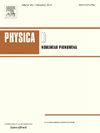Breaking of mirror symmetry reshapes vortices in chiral nematic liquid crystals
IF 2.7
3区 数学
Q1 MATHEMATICS, APPLIED
引用次数: 0
Abstract
Nematic liquid crystals offer a rich playground to explore the nonlinear interaction between light and matter. This richness is significantly expanded when nematic liquid crystals are doped with chiral molecules. In simple words, a favorable twist is introduced at a mesoscopic scale in the system, which is manifested through a characteristic length scale, the helical pitch. A classical controlled experiment to observe the response of chiral nematic liquid crystals to external stimuli, is to fill a liquid crystal cell and apply a continuous electrical current. The aftermath will depend on a balance between the elastic and electric properties of the material, the amplitude and frequency of the electric signal, and the competition between the helical pitch and the cell thickness. Although this balance have been studied experimentally and numerically to some extent, the theoretical side of it has been underexplored. In this work, using weakly nonlinear analysis, we derive from first principles a supercritical Ginzburg–Landau type of equation, enabling us to determine theoretically the intricate balance between physical properties that govern the emergence of some chiral textures in the system. Specifically, we focus on how positive and negative vortex solutions of a real cubic Ginzburg–Landau equation are affected by the presence of chirality. We use numerical simulations to show that +1 vortices undergo isotropic stretching, while -1 vortices experience anisotropic deformation, which can be inferred from the free energy of the system. These deformations are in agreement with previous experimental observations. Additionally, we show that it is possible to break the monotonous spatial profile of positive vortices in the presence of chirality.
求助全文
约1分钟内获得全文
求助全文
来源期刊

Physica D: Nonlinear Phenomena
物理-物理:数学物理
CiteScore
7.30
自引率
7.50%
发文量
213
审稿时长
65 days
期刊介绍:
Physica D (Nonlinear Phenomena) publishes research and review articles reporting on experimental and theoretical works, techniques and ideas that advance the understanding of nonlinear phenomena. Topics encompass wave motion in physical, chemical and biological systems; physical or biological phenomena governed by nonlinear field equations, including hydrodynamics and turbulence; pattern formation and cooperative phenomena; instability, bifurcations, chaos, and space-time disorder; integrable/Hamiltonian systems; asymptotic analysis and, more generally, mathematical methods for nonlinear systems.
 求助内容:
求助内容: 应助结果提醒方式:
应助结果提醒方式:


